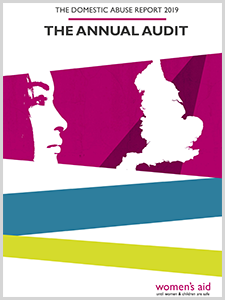The Domestic Abuse Report 2019: The Annual Audit
 The Domestic Abuse Report 2019: The Annual Audit examines the work of domestic abuse services in 2017–18, including changes in the provision of services in England, information about the survivors these services have supported, the work services are proud of and the challenges they have faced.
The Domestic Abuse Report 2019: The Annual Audit examines the work of domestic abuse services in 2017–18, including changes in the provision of services in England, information about the survivors these services have supported, the work services are proud of and the challenges they have faced.
Also available in the Domestic Abuse Report 2019 is the thematic report, The Economics of Abuse.
© Women’s Aid, March 2019
Please cite this report as:
Women’s Aid (2019) The Domestic Abuse Report 2019: The Annual Audit, Bristol: Women’s Aid.
Key Findings
- There was a decrease in the number of most service types in 2017–18, including formal counselling services which have dropped by 18.1% since May 2017. (Routes to Support)
- The number of refuge bed spaces in England falls short of the minimum number recommended by the Council of Europe by 1,715 bed spaces. (Routes to Support)
- Refuge services in England supported an estimated 12,034 women and community-based services supported an estimated 136,165 women in 2017–18. (Women’s Aid Annual Survey 2018)
- 59.7% of all referrals to responding refuge services in 2017–18 were declined. The main reason referrals were declined was a lack of space or capacity to support the survivor (17.1% of all referrals were declined for this reason). (Women’s Aid Annual Survey 2018)
- Just under a third (30.6%) of services report that since 2014 they have had to reduce the amount of support (in terms of staff time) they are able to give to each service user due to funding. (Women’s Aid Annual Survey 2018)
- 54.5% of respondents to the annual survey gave comments on funding and funding uncertainty as their biggest challenge in 2017–18. (Women’s Aid Annual Survey 2018)
- Over half (56.7%) of respondents were running an area of work without any dedicated funding in 2017–18. (Women’s Aid Annual Survey 2018)
- The length of abuse experienced by service users ranged from one month to 60 years, with the average length of abuse experienced being 70.0 months (just under six years). (On Track)
- There are large numbers of children being supported by domestic abuse services, either directly or through support given to their mothers. Over half (58.3%) of service users in 2017–18 had children and 6.6% were pregnant. (On Track)
- However, just under half of refuge vacancies posted on Routes to Support in 2017–18 could accommodate a woman with two children, and only one-fifth could accommodate a woman with three children. (Routes to Support)
“Being able to see survivors on their own journey of change, living a life free from abuse and fear is rewarding. The positive impact that our support has on the wider family as well as the survivor.” (Service responding to the Women’s Aid Annual Survey 2018)
